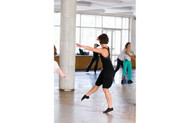What is the Cunningham Technique?
By Move Dance on 22nd Feb 2019
The Cunningham Technique is an abstract dance training programme that's deisnged to simultanteously strengthen the body and mind, improve flexibility, precision and your dynamism as a dancer. It's taught globally in classes and often as part of Dance studies. It's named after Merce Cunningham; the founder of the Cunningham Technique was an American dancer and choreographer who developed this style of dance during his own training. Cunningham was a soloist for Martha Graham's company until he formed his own in 1953 - Graham actually encouraged him to pursue choreography. Cunningham loved the random and abstract, which lead him to devise a form of dancing that was determined by something so uncontrollable as flipping a coin. A true modern dancer, Cunningham challenged traditional ideas of dance so much so that it led him to explore Cage's possibilities of music and the body existing separately from one another whilst on stage. Cunningham may have passed on, but he still wants you to question and challenge dance as you know it to push its boundaries and limitations to create beauty on stage.
Keep reading to learn more about the Cunningham Technique.
The Three Core Principles of the Cunningham Technique
- Strengthening & Flexibility
- Spatial Awareness
- Rhythmic Accuracy
Strenghtening & Flexibility
A series of exercises and movements form the basis of the Cunningham Technique. Each class teaching the technique begins with stretching to ready the legs for the limber support to come that's needed for dance. Ballet positions like plies and second are used during the Technique. Deep stretches follow in the back, including curving and lengthening. A series of other stretches for strengthening and increasing flexibility of key muscle groups and body parts that you'll engage as a dancer, such as your feet, ankles, waist and arms. The Cunningham Technique teaches you to increase your flexibility whilst maintaing correct form so as to not distort your body shape in any way. The Technique keeps your muscles and brain engaged by challenging you to work your torso and legs sometimes in opposition and at other times in coordination. You'll be eased into learning the Technique at a slower pace before the count tempo is increased to test your accuracy.
Spacial Awareness
This section teaches the dancer how to use any space - small or large - whilst maintaining balance and navigating around other dancers. Moving in multiple directions, including sideways and backwards, is key to practising spacial awareness and helping the dancer with their traveling. Turning and spinning is also practised at this stage to again test balance, along with jumps (during which the torso upright must remain upright). As you progress in this Technique, your teacher will introduce not only moving in different directions but also your body parts (like arms and legs) moving in different directions.
Rhythmic Accuracy
Fine-tuning your ability to move your body accurately in time to a piece of music is crucial for a breathtaking solo and even more important for a synchronised group performance. The Cunningham Technique improves your "rhythmic precision" through a series of exercises to make your body and mind cohesive with any musical piece you're presented with. This will improve your diversity as a dancer and increase your confidence to dance to any music or sound you're faced with. Just to keep things interesting, the Technique also tests and improves your ability to move independently to the music. Cunningham believed that "changes of rhythm should be introduced concistently to keep the idea of flexibility alive" - memorise this to keep your work in the Techique strong.
Written with reference to www.mercecunngham.org
Feature image Designed by nikitabuida / Freepik

